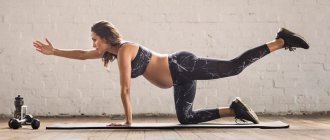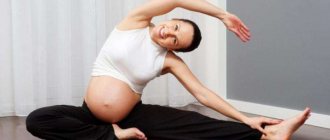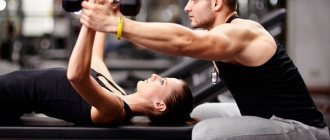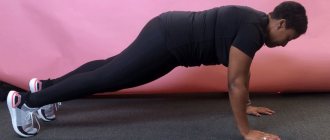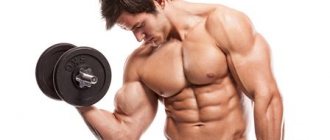What will happen if sports are present during menstruation?
Science answers the question of whether it is possible to exercise during menstruation with the statement that as a result of regular exercise, some symptoms of PMS are alleviated:
- less chest pain;
- no bloating;
- neurosis, irritability and tearfulness do not appear;
- metabolism is stimulated;
- blood circulation improves;
- the delivery of oxygen and nutrition to cells is accelerated.
Improvement occurs when you do not too vigorous workouts. Otherwise, active training only aggravates PMS symptoms.
On the first day of menstruation, the intrauterine lining separates. This, like menstruation in general, is not a disease, but in every woman the symptoms of premenstrual syndrome and the first or second day of menstruation manifest themselves differently: headache, chest, lower abdomen and heart pain, pressure jumps and lack of air, increased sweating, cramps, tingling limbs and frequent urge to urinate. In these cases, the load during training is reduced.
What are the benefits of sports during PMS and menstruation?
Official medicine claims that the correct loads will not only not harm, but will also help a woman these days easier Physical exercises for PMS can:
- reduce the risk of neurosis (irritability, tearfulness, mood swings);
- reduce chest pain;
- improve metabolic processes;
- relieve discomfort in the gastrointestinal tract;
- strengthen the muscles of the uterus.
But this is only true if the woman has given up intense training in favor of calmer ones. Otherwise, the symptoms of premenstrual syndrome may even worsen. And this will already lead to a complete ban on any exercise. But if you can’t imagine your life without sports, then you can find an acceptable way out of the situation . For example, if a girl runs regularly, then on critical days it is better for her to switch to brisk walking or even just walking, but increase the distance. If she does aerobics, it is better to give preference to a light warm-up without jumping.
Training options and cycle phases
The menstrual cycle develops in accordance with three phases:
The duration of the first follicular phase is 10-15 days. There is an increase in folicle hormone and stimulation of the growth of ovarian follicles. The level of estrogen is higher than progesterone. Fat burning occurs faster than sugar. Therefore, training should be less intense.
The period of the ovulation phase is characterized by an increase in the concentration of luteinizing hormone. Ovulation occurs - the egg is released from the ovary into the peritoneal cavity, and the ovarian sac closes. This leads to the production of progesterone, which becomes more abundant than estrogen, as well as active burning of glucose. Then it is recommended to increase the intensity of your training.
Who and why should not play sports during menstrual periods?
It is more difficult for a woman, unlike a man, to lift heavy weights more than 8 times. Therefore, for pain in the lower abdomen you should:
- do not lift heavy weights for 5-8 repetitions;
- eliminate the load on the press, especially the lower one, or replace it with a light exercise;
- exclude deadlifts (strength training), squats, jumps, hyperextension, exercises with body bends and pull-ups.
There are also general contraindications for playing sports during menstruation. Namely:
- heavy bleeding;
- acute pain syndromes in the abdomen;
- migraine headaches;
- exercises with inverted poses;
- gynecological diseases;
- dysmenorrhea - cycle disorder;
- endometriosis or uterine fibroids;
- dizziness and fainting.
Types of sports and exercises during menstruation
During menstruation, you can focus on race walking, jogging, cycling, swimming, yoga, water aerobics, and isolated exercises with light weights. You can devote 30 minutes to classes every day.
How to prepare for training?
- use a tampon or pad (if you are allergic to tampons);
- wear a dark uniform: sweatpants or trousers and a loose T-shirt;
- Avoid tight shorts;
- use natural underwear or like boxers.
Do not drink coffee and Coca-Cola before training - they increase pain in the uterine area. If you lose fluid, replenish your body with additional regular water before training, between exercises and after exercise. This will help reduce fatigue and eliminate headaches.
What exercises should you do during your period? Video training:
How to start a workout?
Stretching exercises can ease abdominal cramps and reduce cramping. Yoga poses will not hurt:
- IP - on all fours, fix the position: arch your back, tuck your head;
- IP - lying on your back, position: pull your knees to your chest, grab your calves with your hands.
For light cardio, brisk walking at a constant pace or light jogging is used to keep the heart and blood vessels active. As for lifting weights, work in accordance with the usual training program is allowed, but the weight and intensity must be reduced.
Visit to the swimming pool
Medicine not only does not prohibit, but even recommends swimming. It helps reduce muscle spasms and lumbar pain.
There is no need to demonstrate a sweeping crawl; a calm pace of swimming or moderate water aerobics is better for the muscular system of the abdomen and body.
Cold water in the pool increases muscle spasms, so you should choose a pool with heated water. For hygiene, you should use a tampon or a special silicone mouth guard.
In the gym
To improve blood circulation, reduce discomfort and pain in the lower abdomen, and eliminate bloating, cardio training using a treadmill, elliptical, stepper or exercise bike is recommended.
Strength exercises are selected only to unload the lower back in a position - lying on your back, side and stomach.
Is it possible to play sports during menstruation - on the first day
Sport is a necessary activity in the life of every person, which keeps him in shape and improves his health. And this applies not only to men.
Every year more and more women begin to lead an active lifestyle, doing jogging, swimming, fitness, and yoga.
And they have a natural question: is it possible to play sports during menstruation, because menstruation is an integral part of their life, which imposes some restrictions on girls during this period! Is exercise harmful during menstruation?
Sports during critical days
- Recommended. It is possible to exercise during your period. In some cases, exercise is even beneficial, especially for those who have severe pain during menstruation. Pain during menstruation is caused by spasms of the uterus, which, by contracting, tries to remove the exfoliated endometrium. Like any muscle, it can be relaxed with the help of special exercises that produce the effect of stretching the contracted muscle layer (slow bending back, shallow slow squats with stretching while standing on your toes up, etc.).
- Prohibited. Active sports during menstruation are absolutely contraindicated, because... increase blood flow to the female pelvic organs, can cause bleeding, loss of consciousness, dizziness, exhaustion of the body, weakened by menstrual blood loss. You cannot run fast, do strength exercises, aerobics, swim in a pool or ponds (this is not hygienic and can lead to infections in the blood and genitals of a woman). During menstruation, any serious stress on the body is prohibited. Active sports before and during discharge can lead to delays.
- Allowed. It is permissible to play sports during menstruation by reducing the load to a minimum: warming up the limbs (swinging your arms, turning your neck), leisurely walking, yoga without twisting (with the goal of only warming up the joints and muscles, without exercises on the lower body). The body should not be exhausted, tired, or overexerted - here it is better to focus on your feelings: as long as the workouts are comfortable, you are allowed to exercise, but if you experience the slightest physical discomfort, you should stop them immediately.
To maintain muscle tone and slightly reduce pain during menstruation, use this set of exercises:
- "Wave". Lie on the floor with your back down. Stretch your arms along your body. Bend your knees so that your feet touch the floor. Relax your abdominal muscles. Breathe not so much with your chest as with your stomach; with deep, tangible breaths, it should expand. Do the exercise for two minutes, during which time do slow, smooth bends up and down with your lower torso.
- "Extension." Stand up straight. Stretch your arms up and stretch as high as possible. Rise onto your toes and stretch again. Do this on your fingers for 10 steps.
- "Cat pose." Get on all fours with your elbows and knees on the floor. Lower your head to the floor, touching your forehead to the space between your elbows. You can tilt your pelvis slightly back. Relax your abdominal muscles as much as possible. Stay there for as long as you want - there is no time limit.
- "Downward Facing Dog Pose." Stand so that your feet and palms are on the floor, your arms and legs are extended, your pelvis is at the top, exactly in the middle. You should end up with a triangle. Tilt your pelvis back a little, stretch your arms, relax your abdominal muscles as much as possible. Stand for no more than 1 minute; you don’t need to do it too often.
- "Snake Pose" Lie on your stomach. Stretch your legs along the floor. Raise your torso vertically, perpendicular to the surface, your arms should be extended along the torso and your palms should be on the floor, your pubic bone should lie on the floor. Slowly, lightly pull the muscles of the abdomen and rib area upward, towards the chest. You can bend your legs at the knees and lift them perpendicular to the floor (“the snake raises its tail”) and again slightly pull the muscles on the ribs towards the chest. Do this only on pleasant sensations, as the body “asks”. You can calmly stay in this pose, without pulling your abdominal muscles away from the pelvic area.
- "Wall". Stand next to a wall, turn your side to it. Place your hand from elbow to palm on the wall. And without changing the position of your legs, slowly bend your side so that your thigh touches the wall, and just as slowly return to your previous position. Repeat the procedure 3 times, then change sides.
There are a large number of yoga exercises that you can do during your period. They will relieve pain, maintain muscle tone, have a beneficial effect on the functioning of the whole body, and give results even with low loads. How to perform such exercises, how long to do them, what poses are contraindicated on menstruation days, learn from this video:
On topic: How many times a week should you run to lose weight?
Exercises that are contraindicated
- torso turns, twisting exercises;
- lifting weights (dumbbells and other weights);
- exercise on exercise machines in the gym (all of them put stress on the legs, abs, or are based on pulling weights with your hands);
- do high-intensity bends;
- do a birch, raise the pelvis too high, take “inverted” poses;
- put stress on the lower back.
Can I use tampons when playing sports?
Many women believe that playing sports with a tampon is the best way out of the situation, because... in this case, leaks are unlikely, and positive reviews of this practice are left. However, not all so simple. During sports, blood flows to the pelvic organs to a significant extent, which increases menstrual bleeding and the load on the tampon:
- during exercise (when discharge becomes more abundant), it becomes saturated much faster and requires frequent changes;
- due to the rush of blood to the pelvic area, the lumen of the vagina may decrease slightly, which creates additional pressure on the tampon, which itself is enlarged due to oversaturation with fluid;
- loads can cause it to move up or down;
- Swimming with a tampon is absolutely prohibited, because... while swimming, it becomes saturated with water, becoming a reservoir and carrier of infection.
The result of playing sports with a tampon can be increased pain, a feeling of fullness, pressure in the vagina, unexpected leaks, and in the case of swimming, infection.
The outflow of fluid during exercise should be free, which is better ensured by using a gasket.
If you are concerned about your aesthetic appearance, it is better these days to exercise at home, where there are conditions for monitoring your personal hygiene.
Source: https://sovets.net/3701-mozhno-li-zanimatsya-sportom-pri-mesyachnykh.html
The subtleties of working out in the gym during menstruation
Many women regularly exercise and visit gyms. They follow a routine and exercise only on certain days. But when menstruation arrives, not all women are ready to quit training for this time. Based on this, many people are wondering whether it is possible to go to the gym during menstruation.
Experts say that going to the gym these days is a bad idea. Since women often feel unwell during menstruation, their lower abdomen hurts and there is weakness. Therefore, if you overload yourself with training, it can get even worse.
Let's summarize
You decide for yourself whether you can exercise during your period, but still try to rest during the luteal phase.
Don't be too hard on yourself if your workouts aren't going as well as you'd like on these days of the month. It's quite normal. Hormones are chemical messengers that control various body functions. Just as melatonin signals sleep, hormone levels signal exercise or rest.
Remember that everyone is different. If hormonal shifts dictate that you train hard during the follicular phase and relax during the luteal phase, then so be it. The best way to exercise for you is the one that works for you!
Lastly, be sure to consult your doctor if you have any questions about your menstrual cycle and exercise routine.
When is it safe to go to the gym?
During the menstrual cycle, changes are observed in the female body, this can also be seen in the woman’s behavior. Each phase of the cycle has characteristic features:
- The first phase is the beginning of critical days. It lasts from 3 to 7 days. In this condition, women experience a loss of strength and severe abdominal pain, and sometimes headaches. These days it is better to give up sports.
- The second phase is follicular. She comes when the period ends. Its duration is 6–7 days. These days, the woman’s body begins to recover and revive. Estrogen increases, the functioning of blood vessels and the heart is normalized, and metabolism is accelerated. You need to train during this period. You will begin to gain a lot of strength and energy. Many girls notice an increase in mood and bursts of vigor. It is also possible to lose excess weight during this period, if you have any. Even in the second phase, the muscles respond well to the load, they recover faster. Therefore, in this phase it is recommended to do more sports.
- The third phase is ovulatory. It lasts for several days. This is the main point, as it serves to conceive a child. During this period there are many chances of conception.
- The fourth phase is the luteal phase. This is the last stage of the monthly cycle, it lasts 12-16 days. It is allowed to train at this time, but it is better to reduce the load. You yourself will feel that you are starting to lose a lot of strength and cannot do very much.
The idea of going to the gym is considered in the first phase of the cycle. Since at the very beginning menstruation is heavy. The woman becomes weak, unbalanced and absent-minded. This condition can discourage you from going to the gym. You can play sports on unpleasant days, but be careful about the load and training time.
What happens in the body during menstruation?
The entire menstrual cycle can be divided into two phases: follicular and luteal, between which ovulation occurs. Follicular begins on the first day of menstruation and lasts until about the 14th day (if we consider a cycle of 28 days), luteal - from the 15th to the 28th day. All this time, changes in hormone levels occur in the body. In this context, we are interested in estrogens and progesterone.
Estrogens are the general name for a subclass of steroidal female sex hormones produced by the ovaries. Estrogens have a strong feminizing effect on the body. They stimulate the development of female genital organs, secondary sexual characteristics of the female type and perform many other functions. Exaggeratedly, we can say that it is estrogens that make a woman a woman.
Progesterone is a steroid hormone that is produced by the adrenal glands, ovaries and placenta during pregnancy. Progesterone is often called the “pregnancy hormone” because it is responsible for all processes in the body associated with preparing for pregnancy and bearing a child.
The graph below shows how the levels of estrogen and progesterone change dramatically throughout a woman’s menstrual cycle.
During menstruation, estrogen and progesterone levels drop sharply. This leads to narrowing of the blood vessels in the lining of the uterus (endometrium). If the vessels narrow, the blood supply decreases. As a result, the mucous membrane begins to separate and be rejected, after which it leaves the woman’s body in the form of bleeding.
It is these processes that can cause poor health during menstruation. Naturally, all physical indicators deteriorate during this period. Even with a strong desire, it is unlikely that you will be able to “set records” at this time - your endurance and strength are less than usual.
In the theory of training professional female athletes and sports physiology, entire methods of training female athletes have been developed depending on the phases of the menstrual cycle. Naturally, in professional sports the approach is much more serious, because girls need to show record results and compete in competitions, regardless of the day of the cycle. For girls who engage in fitness “for health” and to stay in good shape, it will be enough to follow the basic recommendations and, mainly, focus on their well-being.
What is allowed to be done and what is not allowed on critical days?
Hormones change during menstruation, estrogen and progesterone decrease, which leads to weakness in the woman’s body. It is advisable not to pump up your abs or lift weights, at least reduce the number of approaches.
Going to the gym or sitting out this moment at home is the choice of every woman. When she feels normal, there is no weakness or dizziness, she can go. But the following exercises should be excluded:
- press;
- lifting weights;
- squats;
- jumping and bending over the goat;
- strong and sudden body bends.
When a woman is used to going to the gym and does it regularly, she should not refuse such an activity. You can skip a few days if it is weak and there is heavy bleeding, and when the condition returns to normal, go to the gym and exercise calmly.
Do you experience lag during intense exercise?
Often, when a woman suddenly changes her lifestyle, starts going to the gym, stays late at work and much more, the body moves to another level. Menstrual cycle disruptions can be serious. At this moment, do not put off going to the gynecologist. You should consult your doctor and take measures to normalize the general condition of the body.
If you become nervous about the condition, it will make it worse. It is better to take a break and wait until your periods become normal. And then, at a slow pace, start all over again so that the body gets used to strong physical and emotional stress.
Phases of menstruation
As mentioned before, our body is in a different state at different stages of the cycle. This needs to be taken into account when designing your workouts.
First phase - critical days
This is where the most powerful changes in your body occur. This phase usually lasts from three to seven days. The question is often asked whether it is possible to go to the gym during menstruation. Light exercise will not hurt, but will help you cope with pain.
Do not forget about the correct selection of loads. During menstruation, our stamina drops greatly, a loss of strength appears, because of this, the usual training program seems much more difficult than in the days before. This means that strength training, cross-fit, cardio, tabata, exercises on machines and similar loads are better postponed until next time because:
- Most of the energy is spent on renewing and restoring the body, so our body is not ready for heavy loads.
- By forcing your body to exercise during your period, you will discourage yourself from exercising in the future.
Perseverance and resilience are very good, but in difficult times you need to take care of your health and body. But at this time you can do stretching, they will be easy for you, since during this period the muscles are very elastic. And also in this phase you can do yoga, stretching , water aerobics, aerobics, and doing planks. Even with light loads, monitor the condition of your body. If critical days are painful, then it is better to postpone the workout until next time and let your body recover.
Follicular phase
It comes after the critical days and lasts from six to seven days. This period is the busiest. Due to the fact that estrogen levels rise at this time, the functioning of the cardiovascular system begins to improve, the metabolic process accelerates, as a result of which our body is ready for good stress.
Thanks to this you will have a lot of strength. A lot of energy will give you estrogen, which rises in your blood. Most women during this period note a surge of vigor. This means that you are guaranteed a good mood for training . It is also in this phase that your excess weight will be best lost, especially if your goal is to lose kilos.
Even in the follicular phase, muscles are well developed. During the second stage of the monthly cycle, it will be better if you engage in intense training. This is where strength training, cardio, Tabata, cross-fit, and Pilates are best suited. You can change different types of exercises, which will help strengthen muscles and burn excess fat.
Ovulation period
The duration of this phase is from two to three days. As everyone knows, this is the optimal time to conceive a child, the body is in the best shape of its activity and is ideally ready for motherhood. But it is best to postpone training at this phase or leave the tension at a minimum level. During the period of ovulation itself, all indicators still remain at their level, including endurance and strength. You can continue doing cardio. But be prepared for the fact that your strength and energy may suddenly drop and you will have to change the type of load.
How to structure training correctly?
It is worth considering the cycle when playing sports. Monitor every workout and load. If a woman does not feel well during her period, it is better not to go to classes. Exercises should be flexible. Build the training for yourself, not the other way around. A healthy lifestyle, fitness, training, physical activity are all good. But it’s better to think about your health, it’s better not to joke with it, and refuse such stress.
To begin with, you must prescribe your own workouts. It’s easy to carry them out and listen to how you feel. This is important in the first days of menstruation, when they are very heavy.
Also, the load should be increased gradually, and not immediately. This will have a good effect on a woman’s body, her reproductive system and hormonal levels. When your workouts happen once a week, and you give it your all, then a breakdown in the cycle is guaranteed. From this we conclude that you need to exercise in moderation, as well as eat right.
How does sport affect your periods?
A classic example that perfectly demonstrates how sports during menstruation affects the female body are female athletes. Due to heavy loads, they suffer from improper functioning of the thyroid gland. The fact is that the body must direct all its strength to its own recovery. It is known that the female body is under constant stress due to heavy loads, including physical ones. Against the background of this condition, hormonal imbalance develops, which leads to a delay in menstruation.
You should also know that cycle fluctuations occur from the first days after active sports. Sometimes, under conditions of physical activity, the delay is only a few days, but sometimes it can be a week.
It is difficult to talk about the benefits or harm of exercise during menstruation.
Excessive physical activity of a woman almost always becomes a factor that brings menstruation closer. Considering the above, many girls should definitely know whether it is possible to play sports before their period. It all depends on the individual characteristics of the body. But practice has shown that before menstruation it is better to hold off on training.
Exercising during menstruation
Only a doctor can answer such an interesting question as playing sports during menstruation. There are some contraindications for which classes should be stopped. For example, puberty in adolescents. At this time, the body begins to form in adolescents, and the genitals prepare for motherhood. Therefore, it is worth not training during your period, but resting.
Also, those women who have gynecological diseases and very recent infectious diseases should take breaks from sports. If you do not have a regular cycle, or when your periods are very painful, then you should give up physical activity.
It is undesirable to play sports for the following reasons:
- if the woman has recently had an abortion;
- if there is poor ventilation in the hall;
- wear comfortable, loose and light clothing;
- take water with you, as the body will become dehydrated these days;
- start exercises with a short warm-up, for example, stretching;
- when little effort has been expended, it is allowed to increase the load.
During your period, it is better to engage in simple sports. For example, walking, swimming or cycling, as well as gymnastic exercises.
Menstrual days affect the functioning of a woman’s body. They take a lot of strength and energy. Therefore, it is undesirable to burden yourself with additional physical activity. Training should be done at half strength and with minimal energy consumption.
If a woman follows all the rules and advice, then going to the gym during her period is allowed. Also don't forget to see a doctor. It is better to first consult and then lead a healthy lifestyle, since heavy stress can have a bad effect on every woman’s body.
Contraindications
It is necessary to refuse sports exercises during critical days if a woman suffers from chronic diseases of the reproductive organs. Classes should also be postponed if blood pressure is too high or low, there are strong cramps in the lower abdomen, and weakness is bothersome. It is reasonable to postpone physical exercises to another day and replace them with a regular walk in the fresh air.
When a woman’s menstrual cycle is inconsistent, and bleeding is heavy and painful, she should stop playing sports. In addition, there are other contraindications related to women’s health, but these pathologies occur more often.
Excessive physical activity during menstruation also harms young girls during puberty. It is necessary to take a break, since sports activities can provoke disturbances in the formation of the girl’s body.
For women who are seriously involved in sports, menstruation does not always serve as a reason to cancel training. Their body is trained enough to withstand physical activity during critical days.
Sports activities are strictly contraindicated for a woman after an abortion until her next period.
Is it possible for a girl to do fitness during her period?
Every girl dreams of a beautiful figure. There are several paths to ideal forms: diet, massage or physical activity. Fitness classes are gaining popularity exponentially. Memberships to fitness clubs are selling like hotcakes. But what about on the days of the mental cycle? You can do fitness during your period, but according to a special program.
Inconveniences from critical days
For every girl or woman, critical days are not the most pleasant time. Premenstrual syndrome is a joke among men. If you look at it, there is no reason to laugh. Irritability, mood swings and excessive sensitivity are the costs of hormonal imbalance, as well as disruption of the central nervous system and endocrine glands. If we add to this complex the constant feeling of discomfort caused by bleeding, abdominal cramps, nausea and lower back pain that accompany menstruation in some women, it becomes clear that this is not a topic for jokes.
Some European countries are seriously discussing a bill in the healthcare sector, according to which a woman will be able to take 2-3 days of paid leave due to her period. This initiative is justified by the fact that on critical days, representatives of the fairer sex work less efficiently.
In Europe and Canada they are just thinking about this issue, but in a number of Asian countries this practice has existed for a long time.
Physiology of menstruation
Menstruation is a natural process by which a woman's body gets rid of an unfertilized egg. During the premenstrual period, the following physiological changes begin to occur:
- Fluid accumulation occurs. This is due to increased production of progesterone. Body weight increases. The accumulation of water in the muscles negatively affects physical endurance and reduces activity.
- Estrogen levels decrease, causing lethargy. With heavy periods, hemoglobin levels drop and oxygen supply to the muscles deteriorates.
All these factors make you seriously think about whether it is possible to do fitness during your period. For a woman who leads an active lifestyle and follows a workout regimen, exercising during her period can be a serious challenge . In schools, girls are given an exemption from physical education during menstruation. However, when answering the question of whether it is necessary to cancel going to the gym during menstruation, expert opinions were divided.
It is forbidden
So, why should you not exercise during your period, according to many experts? The fact is that during this period, serious processes occur in a woman’s body, primarily related to hormonal levels. Also during menstruation it changes due to the loss of some of its quantity, for example, the amount of hemoglobin decreases. This can affect your well-being. During training, malaise may become quite severe, even to the point of loss of consciousness.
Therefore, for girls who do not tolerate such a period well, it is better to refuse active physical activity. Those whose menstruation is accompanied by heavy discharge should also be careful. Intense exercise can increase blood loss, which can lead to negative health consequences. It is necessary first of all to examine the blood for clotting. If its level is low enough, then fitness classes during menstruation will have to be postponed.
Opinions about fitness classes
Doctors believe that going to the gym during menstruation is not recommended. Increased physical activity can cause menstrual fluid to enter the fallopian tubes and then into the abdominal cavity, which can cause the development of endometriosis, which is very difficult to treat. Also, intense exercise can increase blood loss . Hemoglobin levels will drop even further, which can lead to possible loss of consciousness and subsequent injury.
Thus, it is not recommended to overload the body with heavy training during menstruation. It is better to refrain from cycling and abdominal exercises. In addition, doctors recommend checking the blood for clotting. If this indicator is low, playing sports on critical days is contraindicated.
Another opinion says that you can play sports with limited loads (no more than 20-30 minutes a day). If a girl has an active lifestyle, but does not feel well on critical days, she should not completely give up sports. You can simply replace heavy strength training with gentler yoga or moderate cardio exercises.
During menstruation, the following types of exercise are recommended:
- Jogging and race walking. You should not try to set records for speed and endurance. It is better to try to maintain a moderate pace, taking a step at the first signs of fatigue.
- Visit to the swimming pool. Swimming is very beneficial because it helps relieve abdominal cramps and lower back pain. It is desirable that the water is at a comfortable temperature. It is not recommended to visit the sauna after the pool, because high temperature increases blood loss. Swimming during menstruation in open water is strictly prohibited. On critical days, the risk of catching any infection is very high.
- Cardio loads. Training aimed at improving the functioning of the cardiorespiratory system helps to dilate blood vessels and improve blood supply, which leads to a reduction in pain and eliminates bloating.
- Stretching and Pilates. Stretching exercises are also aimed at improving blood circulation. Training is carried out at a calm pace, increases muscle tone and gives a rejuvenating effect.
What kind of training is allowed?
Whether or not to go to the gym during menstruation is a personal choice for every woman. If you feel well and there is no pain, playing sports is safe and has few restrictions. Before you go to the gym, you need to think in advance about what exercises you can do during your period:
- Training must be done very carefully. Loads should be reduced and exercise should be done at a moderate speed. Active sports will have to be replaced by calmer ones. Workouts in which physical activity is reduced by at least 30% in the first days of menstruation are considered safe for the body.
- The best thing for a woman to do during her period is running. During critical days, jogging will help get rid of pain in the abdominal area. Water aerobics does not harm the body. Stretching to stretch the muscles also eliminates pain. These workouts do not require a lot of energy, and therefore the body easily tolerates them.
- Sports such as yoga and Pilates will not harm your health.
Experts recommend doing aerobic exercise, but with minimal stress on the body, since due to the small number of red blood cells in the blood, a feeling of discomfort arises.
- It is strictly forbidden to pump up your abs or perform other exercises for the abdominal muscle group. The reason for the prohibition is that these movements contribute to an increase in discharge during menstruation, which can cause increased discomfort. You cannot squat or bend over the goat.
- During menstrual periods, you should avoid poses in which the body is in an inverted position. You should also avoid jumping, lifting heavy objects and various exercises using force and sudden movements.
- It is advisable to avoid stress on the lumbar spine so as not to provoke excessive bleeding.
Doctors advise avoiding any stress during menstrual periods. But if the desire to go to the gym still persists, then you should consult a gynecologist so that he can give precise recommendations on exercises that can be performed.
Sports during menstruation
A woman’s body in excellent health is able to withstand physical activity during menstruation. Is it possible to exercise during menstruation? The data obtained suggests that PMS symptoms become easier with constant physical activity:
- Doesn't bother your breasts as much;
- There is no bloating;
- No neurosis, no bad mood;
- Metabolism is restored;
- Blood circulation becomes better;
- Oxygen is delivered much faster.
The effect occurs against the background of performing light but vigorous workouts. Otherwise, there is a high probability of worsening PMS symptoms. It is necessary to take care of your health and not overdo it in an effort to lose excess weight.
Menstruation and sports are compatible
Only a gynecologist can give an accurate answer to the question of whether sports exercises are allowed during menstruation. Most experts agree that if certain rules are followed, sports during menstruation are safe:
- You need to sensibly assess your strengths and not overexert yourself.
- It is necessary to choose the right clothes.
- Conditions in the gym should not cause discomfort to a woman.
- A woman should have clean, fresh water on hand to drink, since dehydration during menstruation is contraindicated.
- Exercises should begin with stretching.
If all recommendations are followed, physical exercises during menstruation will be painless and safe for a woman. When performing any load, movements should be made smoothly, without sudden or rapid jerks.
Read
Also:
- Kegel exercises for women
- Physical therapy when planning pregnancy
- Is it possible to exercise during menstruation?
- Reasons for weight gain during menstruation, fattening and swollen legs
Why you shouldn't exercise during your period
Representatives of the fair sex, unlike men, find it much more difficult to lift heavy weights exceeding the figure eight. For this reason, if you experience pain in the lower abdomen, you should:
- Do not lift heavy weights for eight repetitions;
- Do not exercise the press, especially the lower part, or replace it with a light exercise;
- Do not perform deadlifts, jumps or squats.
In addition, physical activity during menstruation also has general contraindications. These include:
- Copious bleeding;
- Severe abdominal pain;
- Migraine;
- Diseases related to gynecology;
- Irregular periods;
- Uterine fibroids;
- Dizziness and fainting.
Gym during your period
Menstruation often brings a woman a feeling of discomfort: she is bothered by pain in the lower abdomen and sudden mood swings.
On critical days, there is a desire to do something to distract from unpleasant sensations, and some girls prefer to relieve stress by working out in the gym.
Is it possible to play sports on menstruation days? Is it safe to go to the gym during your period? Today, the question of whether it is possible to continue to exercise during menstruation is quite relevant.
Menstruation is not a disease, but there is little pleasant in critical days.
During menstruation, a woman’s body undergoes a natural physiological process that cannot be avoided, and you need to understand that at this time all the woman’s feelings and emotions are heightened and a lot of energy is spent.
The level of hemoglobin and red blood cells drops. All this affects a woman’s endurance during training; she can no longer perform normal exercises with ease.
The hardest time for a woman is at the beginning of her period, so visiting the gym on the first day is not recommended. The body needs time to return to normal. If a woman feels unwell on other days, she should refrain from exercising.
Do's and Don'ts
Whether or not to go to the gym during menstruation is a personal choice for every woman. If you feel well and there is no pain, sports activities are slightly limited and safe. Before you go to the gym, you need to think in advance about what exercises you can do during your period:
- Training must be done very carefully. Loads should be reduced and exercise should be done at a moderate speed. Active sports will have to be replaced by calmer ones. Workouts in which physical activity is reduced by at least 30% in the first days of menstruation are considered safe for the body.
- The best thing for a woman to do during her period is running. During critical days, jogging will help get rid of pain in the abdominal area. Water aerobics does not harm the body. Stretching to stretch the muscles also eliminates pain. These workouts do not require a lot of energy, and therefore the body easily tolerates them.
- Sports such as yoga and Pilates will not harm your health. Swimming in the pool does not require a strong reduction in stress and is not dangerous for a woman during her period.
- It is strictly forbidden to pump up your abs or perform exercises on these muscle groups. The reason for the prohibition is that this exercise helps to increase discharge during menstruation, which may increase the discomfort. You cannot squat or bend over the goat.
- During menstrual periods, you should avoid poses in which the body is in an inverted position. You should also avoid jumping, lifting heavy objects and various exercises using force and sudden movements.
- It is advisable to avoid putting stress on the lumbar spine so as not to provoke excessive bleeding.
Doctors advise avoiding any stress during menstrual periods. But if the desire to go to the gym still persists, then you should consult a gynecologist so that he can give precise recommendations on exercises.
On topic: What is the effect of running?
Recommendations
- To avoid discomfort during exercise, a woman can use a tampon. Unlike a gasket, it reliably protects against leaks during sports exercises. In addition, the tampon does not hinder movement and allows the woman to move easily and without difficulty, performing any movements. You can use a tampon and pad at the same time.
- To avoid heavy bleeding caused by playing sports during your period, you should use tampons whose packaging will indicate that they have a high ability to absorb moisture.
- During exercises that do not require heavy loads, bleeding will not be excessive.
- Instead of tampons, special panties can be used during menstruation. They are believed to absorb more moisture than tampons.
- It is also necessary to pay attention to the fact that sweating increases during menstruation, so sportswear should be light. It is recommended to wear a loose uniform that will not cause discomfort to the woman and put pressure on the pelvic organs.
- To prevent dizziness and nausea during exercise, it is advisable to ventilate the room. Comfortable conditions in the gym are one of the factors for safe sports during menstruation.
- During your period, it is important to take care of your personal hygiene. After training, you should take a warm shower: this not only helps you relax, but also eliminates the risk of pathogenic microorganisms entering the woman’s genitals.
Contraindications
It is necessary for a woman to refuse sports exercises during her critical days if she has chronic reproductive disorders.
Classes should also be postponed if blood pressure is too high or low, there are very strong cramps in the lower abdomen, and weakness is bothersome.
It is reasonable to move physical exercises to a regular day and replace them with a regular walk in the fresh air.
You should also refrain from sports if you are injured or during a period of intoxication. An obvious contraindication is thrush and other pathologies of the genital organs, characterized by an inflammatory process.
When a woman’s menstrual cycle is inconsistent, and bleeding is heavy and painful, she should stop playing sports. In addition to this, there are other contraindications related to women’s health, but these pathologies occur more often.
Attention!
For women who are seriously involved in sports, menstruation does not always serve as a reason to cancel training. Their body is trained enough to withstand physical activity during critical days.
Sports activities are strictly contraindicated for a woman after an abortion until her next period.
Menstruation and sports are compatible
Only a gynecologist can give an accurate answer to the question of whether sports exercises are allowed during menstruation. Most experts agree that if the rules are followed, sports during menstruation are safe:
- You need to sensibly assess your strengths and not overexert yourself.
- It is necessary to choose the right clothes.
- The conditions in the hall should not cause discomfort to a woman.
- A woman should have clean, fresh water at hand, since dehydration during menstruation is contraindicated.
- Exercises should begin with stretching.
If all recommendations are followed, physical exercises during menstruation will be painless and safe for a woman. When performing any load, movements should be made smoothly, without sudden and quick jerks.
Source: https://DrLady.ru/menstruation/trenazhernyj-zal-vo-vremja-mesjachnyh.html
Sports exercises during critical days
When your period arrives, special attention should be paid to race walking, running, cycling, swimming, yoga and light weight exercises. If possible, do half an hour of exercise every day. This will not only help you get rid of pain, but also improve your health and lose unwanted weight.
How to exercise during your period
It is necessary to purchase a tampon or pads in advance, and wear a dark-colored uniform - pants or sports trousers and a loose T-shirt. In this case, it is not allowed to wear tight-fitting clothes. Underwear should be made of natural material, or like that of boxers.
Menstrual cup and sports
Feminine hygiene products for sports
Tampons and pads cannot always provide reliable protection during an active lifestyle.
It’s especially hard for lovers of swimming in the pool, sea or other bodies of water. Critical days force you to give up emotionally enjoyable and healthy activities.
Therefore, for athletic girls, the ideal solution is to use a menstrual cup.
The menstrual cup is worn inside and does not have any strings or wings, like tampons and pads.
The cup holds three times more liquid than tampons or pads, so you need to empty it two to three times less often than changing disposable feminine hygiene products.
Menstrual cups can be worn while swimming, doing yoga, running or any other physical activity.
Menstrual cup - indispensable when playing sports
This could be moderate swimming and meditation, stretching exercises or active martial arts, running and climbing.
The cup will allow you to forget about the inconvenience during menstruation. Even during sports flips and spins, the menstrual cup will provide reliable protection against leaks.
With the bowl you can go to the pool, sauna, stand on your head, jump, crawl, bend over. Any, even the most active sports are available to you on any day!
If the bowl size is chosen correctly, there is nothing to worry about!
Sports and hygiene products:
- Yoga is a calm sport that does not greatly affect the amount of menstrual flow; you can continue to use the hygiene products you are used to. The only limitation is the poses. “Traditional” hygiene products will not allow you to perform most active stretching poses.
- Swimming is an active sport, moreover, everyone knows that it is not recommended to swim in the pool during menstruation; it is not hygienic. A menstrual cup is ideal here, which will protect against infection and prevent menstrual blood from leaking out.
- Fitness is a favorite sport for many women; in addition to training, it also provides emotional relief. Tampons and a menstrual cup are suitable here. Moreover, a menstrual cup will be more preferable during active movements, because... it does not move and will not restrict your movements.
- Other professional sports: athletics, boxing, running, weight lifting, equestrian sports, etc. During training, power and static loads are used, naturally the amount of menstrual blood increases. The cup is able to hold three times more discharge!
- You can use all three types of sanitary products: tampons, menstrual cups and pads. But the ideal option is a menstrual cup; it will protect you for the whole day from an unpleasant “surprise” - leakage.
Regular exercise is the key to good health and longevity, so it would be wrong to deny yourself this.
Do you feel good during your period? Then continue to go about your daily activities, just at the beginning choose a good hygiene product for your period of critical days.
So, can I use a menstrual cup while exercising?
Women who lead active lifestyles love the freedom that a menstrual cup gives them.
The menstrual cup provides the best protection for sports and any physical activity that any feminine hygiene product can offer.
Will the menstrual cup interfere with my use?
Devoted users of menstrual cups note that they are not felt at all when worn, which is one of the most significant advantages of menstrual cups.
As long as you insert the cup correctly, you can forget you're using it at all (except when you need to empty the cup). The cup should not cause any pain or discomfort and should provide you complete freedom from discomfort during menstruation.
When will I know that I need to empty my menstrual cup?
Knowing when to empty your menstrual cup will come with experience as you understand your body and get used to using a menstrual cup.
While the cup should generally be emptied every 6-12 hours, this actually depends on how heavy your periods are, your physical activity, the cup's capacity and your personal circumstances.
You may need to look at your watch more often at first to avoid unpleasant leaking episodes, so you can set the time interval that is right for you.
Can I swim or take a bath with a menstrual cup?
Yes. The menstrual cup can be used without any problems while taking a bath or swimming. The menstrual cup provides reliable and discreet protection in the water.
Yes, you can swim in a pool or pond while wearing a menstrual cup. Since you know that the menstrual cup fits inside, it's invisible, so there's no need to worry about the cord peeking out or keep track of the time until the next replacement.
You can swim with complete peace of mind knowing that your menstrual cup holds up to three times the capacity of pads and tampons. And no one will ever know that you are on your period.
We recommend emptying the cup before bathing.
And it’s probably better not to jump in the pool on the first day of using the menstrual cup. Get used to it gradually. Feel how it fits into your body and work out any nuances with the correct installation of the cup.
For example, if you've had any leaks or your menstrual cup fills up with water after a bath, it's best to find out what's causing these problems before you head to the beach or pool.
In fact, it can be much more comfortable to swim with a menstrual cup compared to a tampon!
The reason bowls are a great option for swimming is that they can be left on for up to 12 hours without the threat of leaking, so there is no need to leave the pool to check or replace.
Additionally, menstrual cups are non-absorbent, so they do not absorb water.
Dirty or chemically treated water could carry the risk of vaginal infections and increase the base for bacterial growth. It is for this reason that you cannot go to the pool with tampons and pads, unlike the use of menstrual cups.
Quite often there are questions about bathing and standing on your head while using a menstrual cup, with concerns that blood may flow back into the body.
Rest assured, due to the anatomical structure, this cannot happen, it is completely impossible.
Therefore, it is quite safe to stand upside down with the menstrual cup in place. Essentially, this is the same as being in a lying or standing position. The bowl should not leak or cause any other problems.
